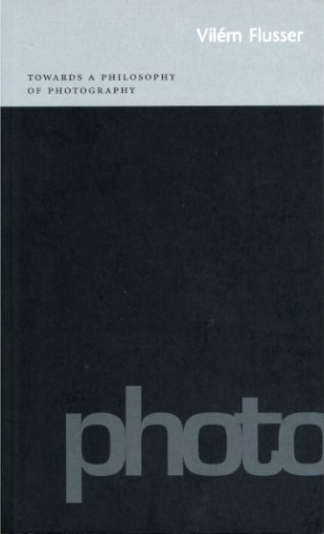
Flusser, V. (2013) Towards a Philosophy of Photography, Cover Image, Reaktion Books.
Over the past couple of days I have read Vilem Flusser’s book Towards A Philosophy Of Photography. Here are some of quotes I found to be of particular interest to me:
“The Magical nature of images must be taken into account when decoding them. Thus it is wrong to look for ‘Frozen Events’ in images. Rather they replace events by states of things and translate them into scenes.” (2013: 9)
I find this to be an interesting visual metaphor, moving the temporality of the photographic image into an equally spacial context.
“The invention of the photograph is a historical event as equally decisive as the invention of writing . With writing, history in the narrower sense begins as a struggle against idolatry. With photography, ‘post-history’ begins as a struggle against textolatry.” (2013: 18)
The terms Idolatry and Textolatry really sound out to me here and the struggle to over come each is of particular interest to my enquiry into the prevalence of the written word and its means of control as a posed to the relative seduction of images but also their relative means of control.
“Nature as a whole is a system in which information disintegrates progressively according to the second law of thermodynamics. Human beings struggle against this natural entropy not only by receiving information but also storing and passing it on – (in this respect they differ from other forms of life) – and also by deliberately creating information. This specifically human and at the same time unnatural ability is called ‘mind’, and culture is its result, i.e. improbably formed, informed objects.
The process of manipulating information – called ‘communication’ – is divided into two phases: In the first, information is created; in the second, it is distributed to memories in order to be stored there. The first phase is called ‘dialogue’, the second ‘discourse’. In dialogue, available information is synthesised into a new phase in which the information to be synthesised can be located in a single memory (as in ‘inner dialogue’); in discourse, the information produced in dialogue is distributed.
Four methods of discourse can be distinguished here: First, the receivers form a semi-circle around the sender, as in the theatre; second, the sender makes use of a series of information conveyors (relay stations), as in the army; third, the sender distributes the information to dialogues which they pass on in an enriched form, as in scientific discourses; fourth, the sender transmits the information into space, as on the radio. Each one of these methods of discourse corresponds to a particular cultural situation – the first corresponds to responsibility, the second to authority, the third to progress, the fourth to ‘massification’. The distribution of photographs makes use of the fourth method.” (2013: 49)
I will use these philosophical theories as the grounding for further research, I feel like Flusser’s ideas around the decimation of culture through its output is central to my inquiries on the distribution of images relating to events. I look forward to learning more about Flusser’s ideas.
Flusser, V., 2013, Towards a philosophy of photography, Reaktion Books,